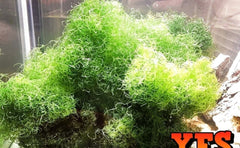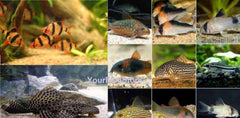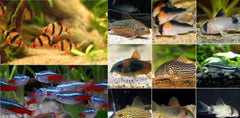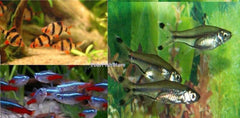30+ Puffers and Cichlids Package - x10 Figure Eight Puffers / x20 South American Cichlids

This Package Includes
x10 Figure Eight Puffers
x20 ASSORTED SOUTH AMERICAN CICHLIDS
~~~~~~~~~~
x10 Figure Eight Puffers
LIVE TETRAAODON BIOCELLATUS FRESHWATER FISH
This package is for x10 Figure Eight Puffers. Puffers are approx 1 1/2 - 3" Each.
The figure 8 puffer (Tetraodon biocellatus) is the perfect puffer for beginner brackish pufferkeepers. It is one of the most colorful of the puffer species, keeping its beautiful markings into adulthood. The figure 8 puffer is friendly, personable and entertaining. And it stays small enough to keep a single specimen in a 15-gallon aquarium.
The first rule to remember: larger is always better when it comes to aquariums for these puffers — remember, they like to swim! I recommend 10 gallons for every extra puffer you may want to add. Also, a longer tank will give them more swimming room than a tall tank. Individual specimens have proven to live longer and seem to have a better relationship with their keepers.
Minimum Tank Size: 30 gallons
Care Level: Moderate
Temperament: Aggressive
Water Conditions: 75-82° F, KH 8-15, pH 7.0-8.0
Max. Size: 3"
Color Form: Green, Tan, White, Yellow
Diet: Carnivore
Origin: Asia
Family: Tetraodontidae
~~~~~~~~~~~~~~~~~~~~
x20 Assorted South American Cichlid SM/MD FRY - FRESH WATER LIVE FISH FREE SHIPPING
They will be scooped out our holding tanks. We cannot guarantee we will be able to scoop ALL different types, but we will try to get a good variety.
This package is for x25 Assorted South American Cichlids FRY / Approx 1"-2" EACH
Possible Random Selection that may be included when we scoop them out of holding tub:

Jack Dempsey Cichlid
Blue Acara Cichlid
Keyhole Cichlid
Green Severum Cichlid
German Blue Ram Cichlid
Peacock Bass Cichlid
Dovii Cichlid
Green Terror Cichlid
Apistogramma Pucallpaensis Cichlid
Thorichthys Ellioti Cichlid
Blue Kribensis Cichlid
Golden Dwarf Acara Cichlid
Vieja Argentea Cichlid
Chocolate Cichlid
Zebra Pike Cichlid
Neetroplus Nematopus Cichlid
Geophagus Altifrons Cichlid
Jewel Cichlid
Gold Severum Cichlid
Acarichthys Heckelii Cichlid
Texas Cichlid
Kribensis Cichlid
Pink Convict Cichlid
Geophagus Jurupari Cichlid
Sajica Cichlid
Krobia Itanyi Cichlid
Rainbow Cichlid
Firemouth Meeki Cichlid
Checkerboard Cichlid
Aequidens Diadema Cichlid
Longfin Gold Ram Cichlid
Paratilapia Bleekeri Cichlid
Vieja Argentea Cichlid
Bolivian Ram Cichlid
Electric Blue Ram Cichlid
Geophagus Brasiliensis Cichlid
Fire Red Apisto. Agassizi Cichlid
Herichthys Bocourti Cichlid
Black Convict Cichlid
Blonde Honduran Red Point Convict Cichlid
Albino Kyoga Red Xystichromis sp. Cichlid
Apistogramma Erythrura Cichlid
Balloon Blue Ram Cichlid
Balloon Electric Blue Ram Cichlid
Bandit Cichlid
Double Red Apisto Cacatouides Cichlid
Electric Blue Acara
Geophagus sp. Rio Negro Cichlid
South American cichlids are attractive, active, are generally quite durable fish. They are found in a range of sizes and with some very beautiful coloration.
Their behaviors are very intriguing, and many interact with their keepers and their environment making them favorite aquarium fish for many hobbyists.
Cichlids are found around the globe, in the Americas, Africa and parts of Asia. The “type specimen” for the cichlid family is the South American cichlid Cichla ocellaris, commonly known as the Peacock Bass or Peacock Cichlid. Thus the American cichlids are sometimes referred to as the “true cichlids” though all species are actually true cichlids.
The South American Cichlids or New World Cichlids are those found primarily in Central and South America, with a number of species native to Mexico, and the Texas Cichlid found in the southern part of North America. The actual number of cichlid species is unknown but estimated at more than 2000, with at least 1300 species scientifically described. South American Cichlids and Central American Cichlids are estimated at about 570 species.
They are categorized as "secondary freshwater fish" - meaning their ancestors were marine fish. It is believed that cichlids moved to freshwaters from the marine environment, and they have features relating to a number of marine species including the damsels, wrasses, parrot fish, and surfperches. This helps to explain why many species can do well in salty water, and in fact some species extend their range into parts of the ocean.
Customer Reviews
No reviews yet
Write a review
QUESTIONS & ANSWERS
Have a Question?
Be the first to ask a question about this.














